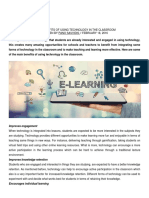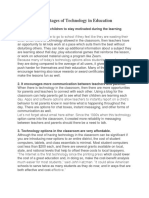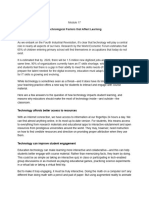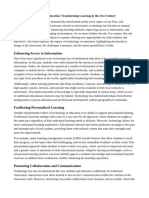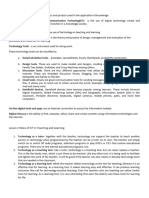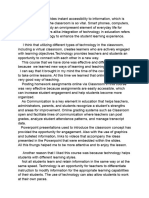Assignment 1
Uploaded by
Gibelle CaguimbayAssignment 1
Uploaded by
Gibelle Caguimbay1. What is your understanding when we say Technology in Teaching and Learning?
Explain (5 points)
For me, when we say Technology in Teaching and Learning is that we are integrating
technology in a way that we can learn something or we use technology in teaching
our students.
On the path to personalizing learning, technology empowers students by giving them
ownership of how they learn, making education relevant to their digital lives and
preparing them for their futures. With technology and access to resources beyond
classroom walls, students are inspired to become problem-solvers, critical thinkers,
collaborators, and creators. Where technology has been successfully integrated into
classrooms, students develop a lifelong love of learning.
Educators are always striving to personalize learning for students. Technology can
help them reach new levels with access to real-time student data, longitudinal
information, content, apps, and more. Technology can help educators create
blended learning environments and leverage digital tools for formative and
summative assessments, bringing new models for learning and teaching to
classrooms.
2. What are the benefits of using Technology in the teaching and learning process?
Give at least 5 benefits. Explain (10 points)
It is important to acknowledge that students are already interested and engaged in
using technology, this creates many amazing opportunities for schools and teachers
to benefit from integrating some forms of technology in the classroom and to make
teaching and learning more effective. Here are some of the main benefits of using
technology in the classroom.
1. Improves engagement
When technology is integrated into lessons, students are expected to be more
interested in the subjects they are studying. Technology provides different
opportunities to make learning more fun and enjoyable in terms of teaching same
things in new ways. For instance, delivering teaching through gamification, taking
students on virtual field trips and using other online learning resources. What is
more, technology can encourage a more active participation in the learning process
which can be hard to achieve through a traditional lecture environment.
2. Encourages collaboration
Students can practice collaboration skills by getting involved in different online
activities. For instance, working on different projects by collaborating with others on
forums or by sharing documents on their virtual learning environments. Technology
can encourage collaboration with students in the same classroom, same school and
even with other classrooms around the world.
3. Encourages individual learning
No one learns in the same way because of different learning styles and different
abilities. Technology provides great opportunities for making learning more effective
for everyone with different needs. For example, students can learn at their own
speed, review difficult concepts or skip ahead if they need to. What is more,
technology can provide more opportunities for struggling or disabled students.
Access to the Internet gives students access to a broad range of resources to conduct
research in different ways, which in turn can increase the engagement.
4. Students can learn useful life skills through technology
By using technology in the classroom, both teachers and students can develop skills
essential for the 21st century. Students can gain the skills they will need to be
successful in the future. Modern learning is about collaborating with others, solving
complex problems, critical thinking, developing different forms of communication
and leadership skills, and improving motivation and productivity. What is more,
technology can help develop many practical skills, including creating presentations,
learning to differentiate reliable from unreliable sources on the Internet, maintaining
proper online etiquette, and writing emails. These are very important skills that can
be developed in the classroom.
5. Benefits for teachers
With countless online resources, technology can help improve teaching. Teachers
can use different apps or trusted online resources to enhance the traditional ways of
teaching and to keep students more engaged. Virtual lesson plans, grading software
and online assessments can help teachers save a lot time. This valuable time can be
used for working with students who are struggling. What is more, having virtual
learning environments in schools enhances collaboration and knowledge sharing
between teachers.
3. Technology can either bring positive and negative effects both on learning and the
learners. Give at least 3 negative effects of technology. Explain. (10 points)
1. Technology is a constant source of distraction.
We are bombarded by short videos and small character limits which only adds to the
problem. As a result, we tend to lose our focus quickly as we surf from one video or
social media post to another.
2. It is much easier to be a bully while hidden away online.
Let's face it; people tend to be much braver hiding behind an online persona. You are
much more likely to say something online that you would never say in person.
The anonymity provided by the Internet caused a rampant cyberbullying problem as
well. It's easier to say terrible things to someone when you may not be held
accountable for your actions.
In the worst cases, some of the things people say online might even be deadly. Youth
suicides are on the rise, and online bullying may be one of the primary causes.
3. Technology addiction is becoming more widespread.
One of the most negative effects of technology is the rise of technology addiction.
Internet use disorder or Internet gaming disorder is a fairly new classification and a
growing trend, but many addicting video games are built with that intention.
We have access to some kind of tech device nearly all of the time and it's hard to
step away. While this type of addiction still isn’t classified in the Diagnostic and
Statistical Manual of Mental Disorders, it is a fast-growing phenomenon with no
signs of slowing.
You might also like
- Strapack I-10 Instruction-Parts Manual MBNo ratings yetStrapack I-10 Instruction-Parts Manual MB26 pages
- Benefits of Using Technology in The Classroom/pros and ConsNo ratings yetBenefits of Using Technology in The Classroom/pros and Cons4 pages
- The Use of Educational Technology Has Therefore Become Important For TodayNo ratings yetThe Use of Educational Technology Has Therefore Become Important For Today5 pages
- Top 6 Benefits of Using Technology in The ClassroomNo ratings yetTop 6 Benefits of Using Technology in The Classroom2 pages
- 22 Advantages and Disadvantages of Technology in EducationNo ratings yet22 Advantages and Disadvantages of Technology in Education1 page
- The Benefits of Technology in Education - Uyen Nguyen Thuc - TEDxYouth@PennSchoolNo ratings yetThe Benefits of Technology in Education - Uyen Nguyen Thuc - TEDxYouth@PennSchool3 pages
- Top 6 Benefits of Using Technology in The ClassroomNo ratings yetTop 6 Benefits of Using Technology in The Classroom7 pages
- 7 Benefits Οf Technology Integration Ιn Τhe Education SphereNo ratings yet7 Benefits Οf Technology Integration Ιn Τhe Education Sphere3 pages
- Lesson 3-Roles of Technology For Teaching and LearningNo ratings yetLesson 3-Roles of Technology For Teaching and Learning36 pages
- Yunes Saeed Ashoor Mhifoodh - Case Study TemplateNo ratings yetYunes Saeed Ashoor Mhifoodh - Case Study Template5 pages
- College of Education: Lesson Plan in Profed06 Objectives100% (1)College of Education: Lesson Plan in Profed06 Objectives3 pages
- Positive and Negative Impacts of Technology On Education: Facebook Twitter Linkedin Pinterest Share Via EmailNo ratings yetPositive and Negative Impacts of Technology On Education: Facebook Twitter Linkedin Pinterest Share Via Email9 pages
- Blue Isometric Elements & Mockups Technology in Education Technology PresentationNo ratings yetBlue Isometric Elements & Mockups Technology in Education Technology Presentation16 pages
- The Use of Technology in Education and Teaching Process100% (1)The Use of Technology in Education and Teaching Process8 pages
- RECORDS OF ACTIVITIES (GRADE 9- KAMAGONG)No ratings yetRECORDS OF ACTIVITIES (GRADE 9- KAMAGONG)3 pages
- RECORDS OF ACTIVITIES (GRADE 9- MOLAVE)No ratings yetRECORDS OF ACTIVITIES (GRADE 9- MOLAVE)13 pages
- Secret Sheet Music For Piano (Solo) EasyNo ratings yetSecret Sheet Music For Piano (Solo) Easy1 page
- 01 Introduction To The Book of Daniel - 1No ratings yet01 Introduction To The Book of Daniel - 150 pages
- Golden Ratio in Architecture-Dessertation-Aman Jain-20191114No ratings yetGolden Ratio in Architecture-Dessertation-Aman Jain-2019111432 pages
- 5 Types of Fish Often Called As The 'Dragon Fish' by Eka RahmadhyNo ratings yet5 Types of Fish Often Called As The 'Dragon Fish' by Eka Rahmadhy3 pages
- Metals and The Reactivity Series CIE iGCSE 0620 PPQNo ratings yetMetals and The Reactivity Series CIE iGCSE 0620 PPQ14 pages
- Documentupload - 254download Full Ebook of Organization Change Theory and Practice 6Th Edition W Warner Burke Online PDF All Chapter100% (8)Documentupload - 254download Full Ebook of Organization Change Theory and Practice 6Th Edition W Warner Burke Online PDF All Chapter69 pages
- Bonnie Effros-Caring For Body and Soul - Burial and The Afterlife in The Merovingian World (2002) PDFNo ratings yetBonnie Effros-Caring For Body and Soul - Burial and The Afterlife in The Merovingian World (2002) PDF271 pages
- NOVEMBER-26_CURFEW-HOURS_THESIS-ANISLAG-EDITEDNo ratings yetNOVEMBER-26_CURFEW-HOURS_THESIS-ANISLAG-EDITED10 pages
- G.R. No 183505 Cir Vs SM Prime HoldingsNo ratings yetG.R. No 183505 Cir Vs SM Prime Holdings11 pages





